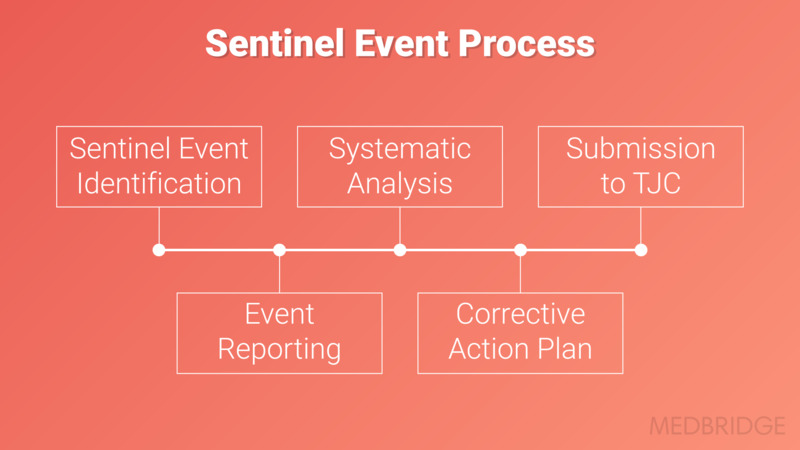A nurse manager participates in a quality-improvement committee seeking to reduce the risk of sentinel events in a healthcare facility. When reviewing recently submitted incident reports, which of the following incidents should the nurse identify as a sentinel event?
The wrong operation was performed on a patient.
A client received an incorrect dose of medication, but it did not result in injury.
A patient complains that a nurse was rude and abrasive.
A nurse withholds a medication upon suspecting that the patient may be allergic to the drug.
The Correct Answer is A
Choice A Reason:
The wrong operation was performed on a patient. This incident is a clear example of a sentinel event. According to The Joint Commission, a sentinel event is a patient safety event that results in death, permanent harm, or severe temporary harm and requires immediate investigation. Performing the wrong operation on a patient is a serious error that can lead to significant harm or even death, making it a sentinel event.
Choice B Reason:
A client received an incorrect dose of medication, but it did not result in injury. While administering an incorrect dose of medication is a medication error, it does not qualify as a sentinel event if it does not result in harm. Sentinel events are defined by the severity of the outcome, and in this case, the lack of injury means it does not meet the criteria.
Choice C Reason:
A patient complains that a nurse was rude and abrasive. Although this behavior is unprofessional and can affect patient satisfaction and trust, it does not constitute a sentinel event. Sentinel events are related to significant harm or risk of harm to the patient, which is not the case here.
Choice D Reason:
A nurse withholds a medication upon suspecting that the patient may be allergic to the drug. This action is a precautionary measure taken to prevent potential harm and is not a sentinel event. In fact, it demonstrates good clinical judgment and adherence to patient safety protocols.

Nursing Test Bank
Naxlex Comprehensive Predictor Exams
Related Questions
Correct Answer is D
Explanation
Choice A Reason:
Human beings tend to be untruthful by default and may not cooperate effectively unless they are held accountable. While accountability is important in any team setting, the statement that human beings tend to be untruthful by default is a broad generalization and not the primary reason for creating group agreements. Group agreements are more about fostering a positive and collaborative environment rather than assuming negative behavior from the outset.
Choice B Reason:
In the absence of agreements, there is an unspoken approval for individuals to conduct themselves however they please. This choice highlights the importance of having clear guidelines to prevent chaos and ensure everyone understands the expected behavior. However, it does not fully capture the essence of why agreements are crucial for team collaboration and conflict resolution.
Choice C Reason:
Agreements help differentiate between team members who cooperate effectively and those who are less productive. While agreements can help identify productive behaviors, their primary purpose is not to single out individuals but to create a cohesive and supportive team environment. The focus is on collective success rather than individual performance.
Choice D Reason:
Agreements emphasize that despite disagreements and gossip that may arise during meetings, these conflicts are never aimed at individuals personally. This choice best captures the essence of why group agreements are essential. They provide a framework for respectful communication and conflict resolution, ensuring that disagreements are handled professionally and do not become personal attacks. This helps maintain a positive team dynamic and fosters trust among team members.
Correct Answer is C
Explanation
Choice A Reason:
Formulating a strategy in collaboration with an interdisciplinary team is an important step in the planning process. However, it is not the initial step. Before developing a strategy, it is crucial to understand the current environment and context in which the program will be implemented. This understanding helps in creating a more effective and targeted strategy.
Choice B Reason:
Creating a vision and mission statement for the upcoming challenge is also a vital part of strategic planning. These statements provide direction and purpose for the program. However, they should be developed after a thorough analysis of the environment. This ensures that the vision and mission are aligned with the realities and needs of the organization and its stakeholders.
Choice C Reason:
Analyzing the environment to identify its strengths, weaknesses, opportunities, and threats (SWOT analysis) is the most appropriate initial step. This analysis provides a comprehensive understanding of the internal and external factors that can impact the success of the fall prevention program. By identifying these factors early on, the manager can develop a strategic plan that leverages strengths, addresses weaknesses, capitalizes on opportunities, and mitigates threats. This foundational step ensures that subsequent planning efforts are grounded in a realistic assessment of the current situation.
Choice D Reason:
Putting into effect a plan of action that’s grounded in evidence is essential for the success of any program. Evidence-based practices ensure that the interventions are effective and supported by research. However, implementing a plan should come after the initial steps of environmental analysis, strategy formulation, and vision and mission development. Skipping these preliminary steps can lead to a plan that is not well-aligned with the organization’s needs and context.
Whether you are a student looking to ace your exams or a practicing nurse seeking to enhance your expertise , our nursing education contents will empower you with the confidence and competence to make a difference in the lives of patients and become a respected leader in the healthcare field.
Visit Naxlex, invest in your future and unlock endless possibilities with our unparalleled nursing education contents today
Report Wrong Answer on the Current Question
Do you disagree with the answer? If yes, what is your expected answer? Explain.
Kindly be descriptive with the issue you are facing.
